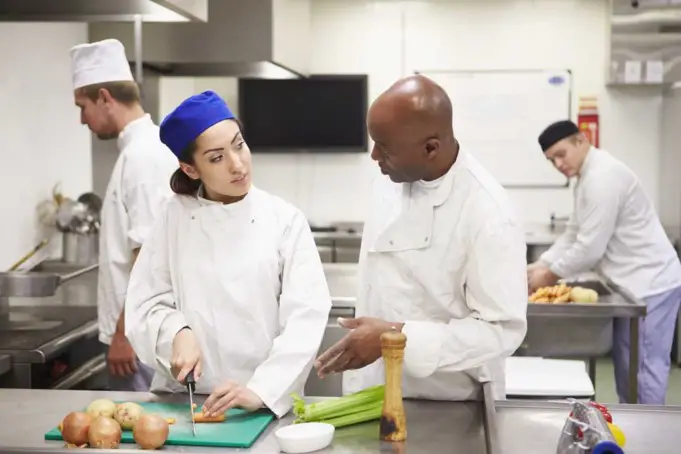You go to local restaurants, eat their food and never know what health issues there are in the kitchen. There are major health issues that can occur, and some of these issues may never get noticed. Safety violations in the food industry are all around us, and chances are that your favorite restaurant may also be at risk of these violations.
If you’ve ever wondered what food safety violations there are and what they mean to your health, then grab a cup of coffee and keep reading.
1. Employees with Communicable Diseases
Employees may have communicable diseases, and these employees have a right to work in the workplace. But there are rules and regulations for these workers:
- Employees with communicable diseases are not allowed in the food prep area
- Gloves must be worn if the following are present: rashes, cuts or sores
Employees with communicable diseases cannot contaminate food, utensils or surfaces. You can view a list of communicable diseases you may be at risk of contracting if a restaurant doesn’t adhere to the above rules here.
2. Hand Washing or Lack Thereof
Hand washing signs are in almost all restaurant bathrooms. These signs are meant to remind staff to wash their hands, and they also act as a good reminder for patrons of the restaurant, too.
Employees are required to wash their hands when:
- Beginning work
- Handling food or utensils
- During food prep
- When switching from raw foods to other foods
- Touching any body part
- Using the toilet
Lack of hand washing can lead to the spread of bacteria or contamination of food. Gloves may be required to be worn, too.
3. Improper Cook Times, Storage Temperatures and Cooling Methods
Patrons can’t control what happens when their food is being cooked. The restaurant has a duty to ensure the following:
- Food is cooked for the appropriate duration
- Food is stored at the appropriate temperature
- Cooling methods are followed
Potentially hazardous foods must be rapidly cooled down to 70F in two hours. Improper cook times and temperatures can lead to the spread of bacteria, food contamination and sickness. Foods must be cooked at the appropriate temperatures. There are even regulations requiring food to be reheated at 165F if it’s considered a potentially hazardous food.
Two or more food items are not allowed to be stored together. All items must be stored separately to avoid cross contamination and help patrons avoid potential allergic reactions. A lot of the peanut allergy scares come from cross contamination of food.
Not following these recommendations can lead to a variety of bacteria entering the food, which can lead to bacterial food poisoning. Other conditions that may also occur include:
- Food poisoning
- Salmonella
- Staphylococcus aureus
- Clostridium perfringens
- Botulism
- Vibrio parahaemolyticus
- Cereus
- Listeria
- Coli
These are serious sicknesses, and you’re always at risk of getting them if your food isn’t cooked long enough and at the right temperature.
4. Sewage and Wastewater Concerns
There are serious concerns about wastewater and sewage at any business. It’s often not the businesses fault when these issues occur, but it is also the responsibility of the business to close until repairs are made.
The facility cannot legally operate if sewage backs up into the facility. A restaurant is required to call in plumbers to correct the issue so that a fully functional sewage disposal system is in place. Failure to shut down operations can lead to food contamination, which can cause a variety of sicknesses, including:
- Diarrhea
- Stomach flu
- Cryptosporidiosis
- Gastroenteritis
- Giardiasis
- Encephalitis
- Hepatitis A
- Leptospirosis
- Salmonellosis
- Paratyphoid fever
- Typhoid fever
- Yersiniosis
These are serious conditions that will often require a visit to the doctor’s office to be remedied.
5. Food Contact with Unsafe Surfaces
All surfaces are required to be cleaned before food makes it on to them. This means, by law, food is never to come in contact with surfaces that are not:
- Cleaned
- Sanitized
Restaurants are required to clean surfaces at “an adequate frequency.” There are also laws in place that require:
- Sanitizer be used in a 3-compartment sink
- All surfaces food comes in contact with must be cleaned and sanitized
Failure to meet these requirements can lead to the spread of bacteria. The restaurant is even required to use different cutting boards or clean the cutting boards when different foods touch the surface.
A lot of the recommendations are common sense, but they will keep you safe as a patron of a restaurant.
6. Food from Unapproved Sources
Food must be sourced from an approved source. This means that the source is properly registered and legally able to sell food. You cannot know where a restaurant sources their food with 100% certainty.
If the food is sourced from a non-regulated provider, this might mean that the food is contaminated, comes from facilities that are not up to code or standard, and unsafe practices may be in use.
7. Rodents or Insects in the Facility
Rodents and insects are a major concern in all food-related establishments. In major cities, it’s not uncommon to see rodents running about throughout the city. Pests will always swarm to a food source.
And restaurants or any eatery will be a prime area for these pests to congregate. Restaurants that fail to get rid of these rodents or pests are leaving their patrons at serious risk of health problems. Rodents destroy food that’s enough to feed 200 million people. Statistics also show that rodents will contaminate 20% of all food.
Rodents can carry diseases and sickness that can make their way into the food and make the patron sick. This is a common complaint in many eateries, and violations are very serious. A top recommendation from the government is for eateries to control pests and get rid of unsafe foods to stop food contamination.
Inspectors will come to restaurants and perform an inspection. But it’s those months between inspections when a small violation can lead to a serious health scare for all patrons. The good news is that restaurants that are cited for food safety violations will often have the violation posted online or in the local newspaper.












